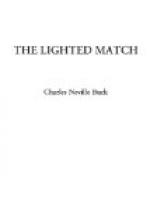Finally he found time to ask: “How long have you been here?”
“Six weeks,” she answered. “And it’s been lonesome.”
“Your answer, Cara,” he whispered. “What is your answer?”
“I am here,” she said. “Don’t you see me? I’m the answer.”
THE END
* * * * *
BIOGRAPHIES
* * * * *
TWO POPULAR AUTHORS
&
SOMETHING ABOUT THEM
* * * * *
[Illustration: Charles Neville Buck]
CHARLES NEVILLE BUCK
Though still a young man—he has only just passed his thirtieth year—Charles Neville Buck, the author of “The Lighted Match,” has travelled far and done much. Although it was as late as January, 1909, that he first settled down to write for the magazines, he has made already an established reputation as a short story writer, and promises to make an even greater name as a novelist. His first novel, “The Key to Yesterday,” was one of the successes of the last publishing season, and we shall be greatly surprised if “The Lighted Match” does not prove still more popular.
Born in Louisville, Ky., he visited South America with his father, the Hon. C. W. Buck, United States Minister to Peru. Since then he has travelled in Europe, covering the ground where he places the scenes in “The Key to Yesterday” and “The Lighted Match.”
After graduation, Mr. Buck studied art, and for a year was the chief cartoonist on Louisville’s leading daily paper. He then turned to editorial and reportorial work, which brought him into close contact with Kentucky politics and the mountain feuds. In 1902, while still a reporter, he was admitted to the Bar, but never practised.
Successful as he is at the short story, it is in the novel that Mr. Buck does his finest work. The novel rather than the short story gives scope for those little touches which make for style and atmosphere, and it is at these that Mr. Buck peculiarly excels. The vivid interest of his plots is apt to blind the reader to this merit, for Mr. Buck’s novels have what some consider the only virtue of a novel, that they can be read for the story alone; but it is there, nevertheless, and for some constitutes the greatest charm of his work. In “The Lighted Match,” even more than in “The Key to Yesterday,” is this artistic finish noticeable. “The Lighted Match” is not only a bully good story, it is literature as well.
[Illustration: P. G. Wodehouse]
PELHAM GRANVILLE WODEHOUSE
During the past year a phrase has been frequently heard among magazine and book men in New York when the name of Pelham Granville Wodehouse has been mentioned. This phrase is “the logical successor to O. Henry”—and it is misleading. Any humorist who tried to follow in the tracks of O. Henry would be merely an imitator and the task would be as unwise as though O. Henry had cramped his own freedom in an effort to walk in the footprints of Mark Twain or any other predecessor in the field of humor.




